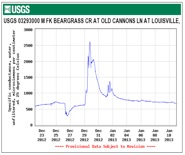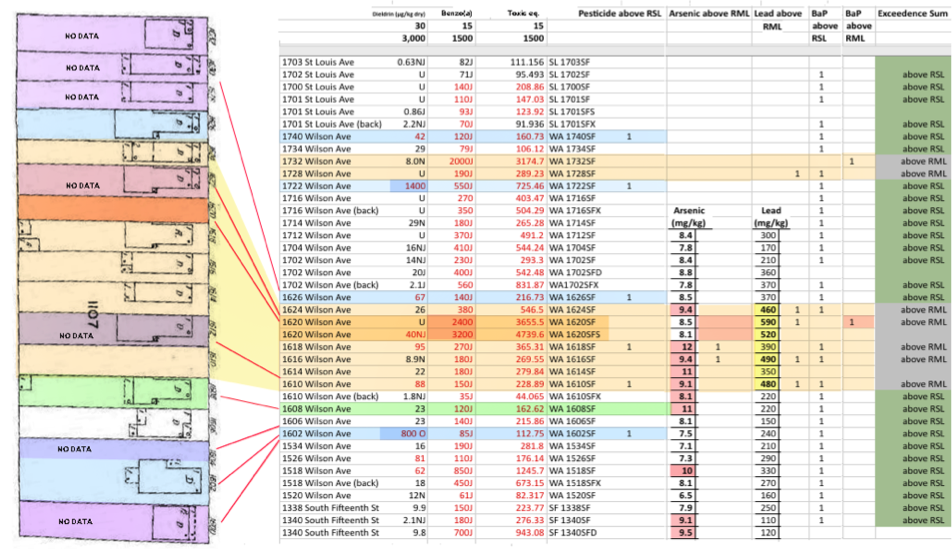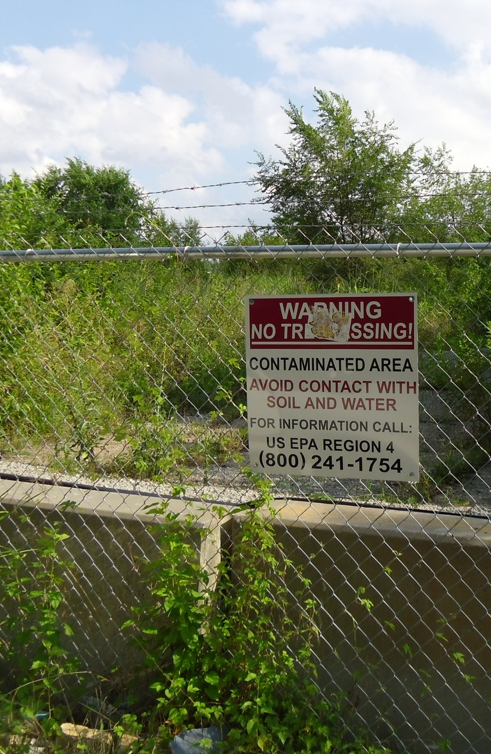


Jefferson County, KY Kitchens
Simple food for a sustainable planet
Traditional farm grown apples with flaky pastry
baked for a brunch with fresh coffee
See more low carbon footprint foods at
Green Eatz
<http://www.greeneatz.com/foods-carbon-footprint.html>
made by Mary Lowe on
July, 2013
Diane Burko paints and photos climate change impacts HERE
JCPS School Bus fleet and widespread asthma HERE
Barry Barker discusses transit in Louisville HERE
NO TIGER FUNDS FOR TRANSIT?
Global threat of green house gas emissions reach Kentucky transportation planning
Religious Leadership presiding over economic decline in West Louisville
HERE Updated
School to Prison Pipeline:
Anthony D. Perry’s passion for justice brings new light to Jefferson County Public Schools ‘zero tolerance’ policy and race disproportionate
academic suspensions
CART Challenges fundamental traffic
forecasts used to justify
$10 Billion Bridge Porkject
Indiana Transportation Department seeks CWA permit to build bridge piers in Harrods Creek
Kentucky Division of Water taking public comment on the Clean Water Act Section 401 Water Quality Permit CART comments and how to submit your own comments HERE
East End Bridge
Most viewed page HERE
Cars, Tires and the Environment
Poverty is the raw resource, Crime is the extractable product and
Corrections is the value added process HERE
Conductivity Peaks Seen In Local Streams Following Road Salting
Road salt flows by groundwater to Jefferson County streams. HERE
UPDATED to show
300 microsiemens macroinvertebrates
exterpation
EPA And KYDOW forging narrow Floyds Fork TMDL
ROADSALT
dumped by the ton, it accumulates chloride polluting fresh water
Badwater’s
book selection page for a selection of books and articles - anti-proto-fascist,
pro-environmental and off the beaten path. HERE
FFEA sounds alert against watershed pollution credit trading
Developing Floyds Fork
Lawn Turf chemicals
On the Road in
New Mexico
Mayor’s response to
West End disinvestment
BadwaterJournal.com
WHAT UNSUSTAINABLE URBAN GROWTH LOOKS LIKE
This website, BadwaterJournal.com is created, maintained and published by
Clarence H. Hixson
email: budhix@iglou.com
1336 Hepburn Avenue
Louisville, KY 40204
who is solely responsible for its content. All rights reserved © 2013 Clarence Hixson

See FLOYDS FORK

It was a pleasant fiction of the Clean Water Act . . . that water quality could be protected and restored, while millions of people settle in and develop a watershed with modern consumer culture based on transportation and consumption of material goods.
But, in the first decades of the 21st century we have to confront the reality that the CWA has failed . . . We do not share the watershed with our fellow creatures– we take it for our pollution disposal.









“The best available evidence suggests the amount of the gas in the air has not been this high for at least three million years, before humans evolved, and scientists believe the rise portends large changes in the climate and the level of the sea.”
“It symbolizes that so far we have failed miserably in tackling this problem,” said Pieter P. Tans, who runs the monitoring program at the National Oceanic and Atmospheric Administration that reported the new reading.”
Justin Gillis in the NYTIMES
May 10, 2013
Carbon Dioxide Level Passes Long-Feared Milestone
Scientific monitors reported that CO2 had reached an average daily level that surpassed 400 parts per million


"The environmental community is basically asking governments to try to reduce their emissions and asking them to subsidize
clean energies. Well, that simply doesn’t work because we don’t get enough energy from the renewables to make a difference.
And that then forces any government to approve expanded oil drilling, hydro-fracking to get more gas, mountaintop removal to get coal. We’re not going to turn the lights out. No government, no president or governor is going to turn out the lights. There has to be energy. If renewables aren’t providing it, it’s been fossil fuels."
Jim Hansen quoted in NyTimes
Published online at Louisville, Kentucky USA -
An independent, secular, contemporary journal of political and environmental issues dedicated to peaceful reduction of human impacts on Earth






Alternative media blogs
Urban Louisville
http://urbanlouisville.blogspot.com/
Louisville Courant
http://louisvillecourant.blogspot.com/



Unique hand crafted in Kentucky
wire wrapped pendants
Selected natural crystals artistically wrapped by
sterling silver-no drilled or glued stones.
Select and Order online



Creek in Shelby County
CONDUCTIVITY LETHAL TO LOUISVILLE STREAMS
Highway runoff levels in Louisville Kentucky deliver conductivity readings above 2500 microsiemens per centimeter yet water groups petition to EPA to mandate state level numerical conductivity limits is targeted at mountaintop removal, and seeks a numerical limit of 300 microsiemens per centimeter. Look at the graphs obtained from USGS HERE. They go a long way to explain the absence of stream diversity in urban impacted waters (Beargrass Creek) where automobile metal scrapings --nickel, copper, zinc, iron, manganese and road deicing chloride, cause spikes in conductivity levels.
See Petition at EarthJustice HERE
“In 2011, EPA published two peer-reviewed scientific reports documenting the harm caused by conductivity and mountaintop removal mining valley fills. This research showed that a significant percent of aquatic life is extirpated when conductivity reaches 300 microsiemens per centimeter (μS/cm). While EPA’s 2011 guidance based on that research has been nullified by a district court for procedural reasons, that case is on appeal, and the court did not question the underlying science which remains valid.”
July 2011 Guidance at 16 (citing EPA Office of Research & Development Final Report: A Field-based Aquatic Life Benchmark for Conductivity in Central Appalachian Streams
(May 27, 2011)).
"Extirpation concentrations of specific conductance were estimated
from the presence and absence of benthic invertebrate genera from 2,210 stream samples in West Virginia. The extirpation concentration is the 95th percentile of the distribution of the probability of occurrence of a genus with respect to specific conductance. In a region with a background of 116 μS/cm, the 5th percentile of the species sensitivity distribution of extirpation concentrations for 163 genera is 300 μS/cm. Because the benchmark is not protective of all genera and protects
against extirpation rather than reduction in abundance, this level may not fully protect sensitive species or higher-quality, exceptional waters."
"Using the same water quality data used by EPA, but a different statistical method for analyzing that data, they independently derived a threshold of 308 μS/cm for biological impairment related to increased conductivity. That value is essentially the same as the 300 μS/cm lower value in the range cited in EPA’s 2011 guidance and derived in 2012 by Cormier et al."
KENTUCKY HOSTILITY TO BLACK AMERICANS SHOWN IN INDIFFERENCE TO UNEMPLOYMENT, SCHOOL SUSPENSIONS, CORRECTIONS STATISTICS
See updated article HERE

At a Louisville River Road barge terminal a mountain of road salt sits waiting to be used for deicing in winter weather.
Lower DUI breath alcohol to .05? What will that stop?
Population Jefferson County 746,906 - Jul 2011
.14 % of the population of Jefferson county arrested for DUI in 2011
Population Kentucky 4,369,356 - Jul 2011
.59 % of total state population arrested for DUI in 2011
Jefferson- 17% of total state population but 4% total state DUI arrests
<http://abc.ky.gov/Pages/default.aspx>
ABC Statistic—Kentucky has 32 “wet” counties, 39 “dry” counties and
35 “moist” cities located within dry counties. (Revised 8/14/12)
2011 State total DUI arrests -- 25,841 (KSP Crime Statistics 2011)
Jefferson County DUI arrests DUI – 1,046 814 white 223 black
Jefferson County is second highest in DUI arrests in the state behind Warren County with 1,211 arrest for DUI in 2011. (Go WKU!)
Jefferson --252 retail package outlets 260 retail drink establishments
“Even in the best of economic times, unemployment among African Americans tends to be substantially higher than the jobless rate for the country as a whole. With this in mind, the Joint Center for Political and Economic Studies took a closer look at what happened to this disparity during the Great Recession and the early years of the economic recovery. What we found was that across most age, gender, educational and geographic categories, the recession severely aggravated black unemployment, leaving sharply widened gaps between African Americans and the general population that were persisting two years after the start of the recovery.”
April 2013 Report: Further to Go, Job Creation in African American Communities
Beargrass Creek Louisville July 20, 2013



Public comment sought on report about
Floyds Fork stream impairments
Comment period extended to August 29
A report, prepared by the Kentucky Division of Water (DOW), addresses bacteria impairments in the 18 stream segments that make them impaired for the primary contact recreation (swimming) and secondary contact recreation (boating and wading) designated uses. The report includes data and procedures used to calculate the TMDLs for the stream segments. The report also includes nine stream segments that have not been previously listed as impaired. Public comment is being sought on both the TMDL and the new listings. Revisions to the report may be made following the public comment period and before it is sent to the U.S. Environmental Protection Agency for approval.
The report may be viewed on the DOW website at
http://water.ky.gov/Pages/PublicNotices.aspx.
Comments should be sent in writing to Andrea Fredenburg, Division of Water, 200 Fair Oaks Lane, Fourth Floor, Frankfort, KY 40601 or by email to Andrea.Fredenburg@ky.gov.
“Some scientists believe we are now in the midst of another great extinction, driven not by natural events but by the activities of man: hunting, habitat destruction, the introduction of invasive species and pollution, which has drastically altered the thin glaze of life-supporting chemistry that coats the earth. By some estimates, perhaps close to 30,000 species of plants and animals go extinct every year. Whole ecosystems, like coral reefs, which went virtually extinct in the end-Triassic extinction, are now facing worldwide collapse again.
A World Bank report last fall warned that “present emission trends put the world plausibly on a path toward 4 degrees Celsius warming within the century.” The surface waters of the carbon-dioxide absorbing oceans have already become 30 percent more acidic since the start of the Industrial Revolution.
“In terms of global warming and ocean acidification,” Professor Olsen said, the rate of change during the end-Triassic extinction “was comparable to what we’re doing today.”
As I looked up the cliffs I wondered what we would leave to the ages. If catastrophe strikes, would future geologists find evidence of New York, a marker for our time, just as the Palisades have survived as a tombstone for another era?
“No,” he said. “It would be eroded away fairly quickly.”
Peter Brannen is a science journalist based in Washington.
New York Times August 17, 2013



Lockport dam on the Kentucky River
Henry County August 2013

DON’T USE NaCl
DEICING SALT
on sidewalks and driveways.
Road salt runoff is killing stream aquatic
insects that support fish and warm
freshwater ecosystems.
Salt runoff poisons groundwater and
is killing Beargrass Creek from mall
parking lot and interstate deicing. Salting
sidewalks causes concrete to crack.
Want to help Beargrass Creek?
Stop using roadsalt. See more here
See USGS road salt results here

How the automakers and EPA subverted the Clean Air Act and made your kids sick
Final Order in Bridges lawsuit denys Kentucky Transportation Cabinet engaged in intentional racism in designing tolled bridges with disparate impact on poor HERE

Chemical contamination to stormwater
from Black Leaf site not discussed
Feral kittens seen through the perimeter fence at the Black Leaf site
In July 2013 torrential rain fall events caused water to pool up in the street along the blocks of Wilson Avenue between 15th and Dixie Highway. According to the neighbors, water cascaded off the low concrete perimeter wall in the alley that divides the Black Leaf Superfund site from the neighborhood.
The storm drainage problems of the area take on new importance since the EPA disclosed very high concentrations of toxicants like arsenic, lead, banned organo-chlorine insecticides-- lindane and dieldrin, and PCB and dioxin related compounds including benzo(a)pyrene.
Persistent organic pollutants from Superfund sites, with significant toxic effects on humans and wildlife are found to migrate offsite through various pathways and into the storm sewers, into receiving waters, onto highways and inside homes. Mothers breast milk and fatty tissue accumulate concentrations of these compounds and dieldrin and lindane in particular have been found to cause disruptions of cell signals and affect the developing nervous systems of children. Heusinkveld, Westerink, Organochlorine Insecticides Lindane and Dieldrin and Their Binary Mixture Disturb Calcium Homeostasis in Dopaminergic PC12 Cells, Environ. Sci. Technol. 2012, 46, 1842−1848.
“Due to the high lipophilicity of dieldrin (log Kow 6.2) and lindane (log Kow 3.9), concentrations in breast milk are in general considerably higher than blood concentrations.”
Various pathways include tracking contaminated soil into the home from outside. The local neighborhood children grew up on Wilson Avenue playing in the dirt, stomping in puddles and bringing the contamination inside on their clothing and shoes. This migration indoors throws into question the sufficiency of the plans to remove 12 inches of topsoil in the neighborhoods.
The data released from EPA shows widely varying concentrations of toxicants up and down the block based on individual soil samples taken on site. See map below. These wide variations indicate activity like carrying chemicals offsite and applying them to the soil, washing offsite from storm flows, spilling from truck traffic and dumping. EPA’s Freedom of Information Act released data does not include topo map information to locate stormwater flow channels nor detailed maps showing areas of highest concentration. Like a lot of chemical companies, the pesticide manufacture shut down with the Congressional action creating the Clean Water Act in 1970. These operations were too dirty to comply with environmental regulations.
Pooling stormwater and other water issues have not been described in the EPA literature. At the insecticide manufacturing plant building site on the south side of the 29 acre property, sewer maps indicate sewage pump stations that lifted storm water and sewage into the local sewer collection system operated by MSD. That collection system is a combined sewer system that overflows in wet weather north of the Morris Form Treatment plant located on Algonquin Parkway at the Ohio River.
Two major Combined Sewer Overflows with discharge outlets more than ten feet in diameter overflow untreated sewage in wet weather adjacent to Shawnee and Chickasaw Parks and transport toxicants from the Superfund site through to sewer system to the Ohio River. One major stormwater collection route runs down West Broadway. So far it appears that EPA is ignoring the stormwater issues and the long distance off-site transport of the chemicals to other neighborhoods.
February 2013 EPA Fact Sheet
“The Black Leaf Chemical Site is a former pesticide formulating facility located in the Louisville Industrial Park at 1391 Dixie Highway in Louisville, KY. The Site, which is located on a 29 acre property in the Park Hill neighborhood operated from the 1930s to the 1970s, and handled pesticides such as Black Leaf 40, DDT, Dieldrin, and Lindane.
Site investigations in 2010 and 2011 confirmed the presence of DDT and dieldrin in surface soils on the industrial property. Elevated levels of arsenic, lead, and polycyclic aromatic hydrocarbons (PAHs) were also discovered. Arsenic is known to cause cancer and DDT, dieldrin, and certain PAHs such as benzo(a)pyrene (BaP) are classified as probable human carcinogens.
In 2012, EPA and the Kentucky Department for Environmental Protection (KDEP) collected soil samples at 69 residential properties adjacent to the Site. BaP was found at concentrations exceeding KDEP's screening levels at all 69 locations. In addition, there is evidence that arsenic, dieldrin, and lead have migrated from the industrial property into residential yards surrounding the Site.”
Living near a Superfund site
“Numerous social scientific studies have documented the adverse impacts of contamination on individual and community well-being. Communities burdened by toxic waste often worry not only about impacts on ecological

Dieldrin Benzo(a)pyrene Toxic Equivalent Arsenic Lead

DON’T USE
Coal Tar based
driveway sealant
on sidewalks and driveways. These
driveway sealants are now determined
to be significant sources of PAH -
polynuclear aromatic hydrocarbons that
runoff to streams, put carcinogenic
compounds in the air and soil and are
tracked into homes and schools. PAH
kill benthic organisms in stream beds
and high concentrations are associated
with urban and suburban development.
Want to help Beargrass Creek?
Stop using driveway sealant.
Mahler, Meter, Crane, et al, Coal-Tar-Based Pavement Sealcoat and PAHs: Implications for the
Environment, Human Health, and Stormwater Management, Environ. Sci. Technol. 2012, 46, 3039−3045

rear yard soil replacement on Wilson Avenue





or human health, but also struggle with psychological stress and loss of community cohesion (4–7). Living with toxic contamination is inherently stressful and demands some kind of coping response.
Adverse ecological and health outcomes associated with toxic exposures are often identified initially by people living in the contaminated communities (7). Communities affected by pollution and concerned about environmental hazards frequently request assistance in investigating suspected toxic contamination from their local or state departments of public health, but are often frustrated with the responses.
Residents of toxic communities often come to question beliefs that are usually taken for granted, such as the idea that technology and science are benign and positive forces, experts know best, the marketplace is self-regulating, and the government exists to help the people.”
Excerpted from: Brown Superfund Basic Research
Program: A Multistakeholder Partnership Addresses Real-World Problems in Contaminated Communities Environmental Science & Technology / Vol. 42, No. 13, 2008
(emphasis added)
Ignoring West Louisville HERE
Vision Louisville: How about reclaiming the Superfund sites and providing home loans for those affected by the contamination?

Wilson Avenue and area residents offered free blood screening for arsenic and lead
Dr. Matthew Cave of the UofL medical school informed residents of the Black Leaf neighborhoods that up to 100 could be tested for arsenic and lead levels. The free screening was announced at a meeting at the California Neighborhood Center in the Park Hill neighborhood on August 1, 2013. The meeting was facilitated by Dr. Lauren Heberle and others from the UofL Center for Environmental Policy and Management (CEPM) and Metro Council representative David James who provided some funding.
Tom Fitzgerald of the Kentucky Resources Council told the residents that the screening results could trigger the running of the one year statute of limitations to file a personal injury lawsuit against the polluters who contaminated the area properties. The residents seem to have little understanding that in Kentucky they could recover damages for loss of property value and personal injury. According to, Smith v. Carbide and Chemicals Corp., 298 F.Supp.2d 561, 573 (W.D.Ky. 2004):
“[C]onsistent with Wilhite and Mercer, that the invasion of property by contaminants which are imperceptible to ordinary persons cannot, as a matter of law, support either a nuisance or a trespass (negligent or intentional) claim absent proof that the contaminants constitute "a scientifically demonstrable health or safety hazard" at the levels shown to be present on the property.”
The levels on the Wilson Avenue properties should easily support this finding with Dieldrin at 800 ppm and B(a)P at 3200. The UofL CEPM ‘crisis management’ unit did not put informing the neighbors of the advisability of a lawsuit to recover damages at the top of the agenda. That may be the only way to make them whole.
See the freedom of information website with more information:
https://louisville.edu/cepm/former-black-leaf-chemical-site.html
In its recent challenge to the Louisville Bridges Project, the Coalition for the Advancement of Regional Transportation (CART) was overruled by Federal District Court Judge John Heyburn on its claims that the Transportation Department failed to give a ‘hard look’ at air pollution issues.
The claim was well stated by the Judge in his Order granting Summary Judgment against CART:
“Defendants argue that their only duty under NEPA concerning analysis of air quality impacts is to follow CAA guidelines. The CAA requires that certain transportation projects comply with its policy and regulatory goals. Accordingly, Defendants must make conformity findings for the Project at the regional level and the project level. The Administrative Record shows that Defendants performed the required CAA conformity analyses. Defendants assert that because of this, they satisfied their burden under NEPA by ensuring conformity with the State Improvement Plan, Horizon 2030, the Transportation Improvement Plan, and the hot spot analysis requirements.
While CART seems to concede that Defendants properly performed these analyses, it argues that Defendants should have done more than what the CAA framework requires and investigated the impacts of ultrafine particulates.
CART has not identified any requirement under the CAA or elsewhere mandating the examination of ultrafine particulates. The NAAQS only determine the national standards for fine particulate, and the record evidences that Defendants studied this matter. In addition, the CAA requires detailed and demanding conformity analyses of critical impacts to air quality as defined by the EPA, an agency with considerable expertise and institutional knowledge on the subject. The Court concludes that performing and completing the conformity analyses described in the CAA satisfies Defendants’ hard look requirements for air quality issues under NEPA, and Defendants completed this task. The regulatory framework does not require specific consideration of ultrafine particulates, so Defendants’ failure to conduct a thorough investigation of this matter is excused. Defendants’ consideration of air pollution issues was reasonable.”
The Courts decision is curious since under the regulation authorizing the case, NEPA, the transportation agency is charged with determining whether an action "significantly" affects the quality of the human environment, which under 42 U.S.C. § 4332(2)(C), requires " considerations of both context and intensity." 40 C.F.R. § 1508.27.
That statute provides no exemption for environmental impacts that have yet to be regulated but nevertheless have substantial impacts on the human environment. Therefore its difficult to see how an agenciy’s determination to ignore and failure to estimate the impact of ‘nano-particulates’ is reasonable notwithstanding the failure of EPA to regulate them.
[The author is the attorney for CART in the Bridges lawsuit]
Now a new article in Environmental Science and technology joins several others in describing how automakers adjusted their engines so that emitted soot particles of large mass size would be reduced while unregulated finer nano-particulates would be increased. In so doing the automakers and their corrupt regulators were able to claim improvements in Clean Air Act particulate monitored levels, while the community air filled up with unregulated nano-particulates.
In the absence of EPA action, a flood of articles is sounding the alarm bell for health impacts resulting from high concentrations of nano-particulates, not measured or monitored under Clean Air Act regulations.
Judge Heyburn was right, no CAA regulations require monitoring nano-particulates, but that decision did not determine the extent of human health impacts and the scientific literature would seem to demand it.
The latest article is, Huan Liu,Topi Rönkkö, and Jorma Keskinen,
Impact of Vehicle Development and Fuel Quality on Exhaust
Nanoparticle Emissions of Traffic, Environ. Sci. Technol. 2013, 47, 8091−8092:
Emission standards vary widely, depending on vehicle or engine class and country. Until recently, the basic approach has been to decrease particle mass emissions, which mostly affects the emission of soot particles. The successive implementation of stricter PM emission limits have been efficient, leading into a significant decrease of soot particle mass emissions. However, the exhaust of modern vehicles contain nanoparticles. They differ from soot particles by their size, being typically smaller than 30 nm in diameter, by formation process, and by physical and chemical characteristics.
Consequently, the effect of technical abatement methods on them is different. Due to the small particle size and the formation process, where most of the particle mass is formed during exhaust cooling process in the atmosphere, the present emission regulations do not take into account these particles.
However, several urban air studies conducted in the vicinity of traffic, for example, ref 3, report ambient air particle number size distributions dominated by nanoparticles. Thus, when the whole of traffic is considered, nanoparticle number emissions seem to be at the same or even higher level than soot particle number emissions . . .
Nanoparticles or so-called nucleation mode particles have been
observed in vehicle exhaust in several studies covering passenger cars and heavy duty vehicles with very different technologies. These studies together with roadside measurements of traffic related particles indicate that people near traffic are exposed to these particles. Due to their small size, the particles can penetrate deep into the lung, with possibly adverse health effects.
EPA and the automakers are sitting on a national health disaster by failing to add nano-particulate emission standards to the Clean Air Act. These regulations have been denied for more than a decade with resulting severe heath impacts to millions. EPA is selling coverage to the automakers and selling out the health of our children in the process.

State Audit of Metro Air Pollution Control District shows inept lab practices
Louisville’s air monitoring for soot or particulate matter is in the hands of Metro Air Pollution Control District lab employees and apparently those hands lacked sufficient training at least for the year 2012. The results for 2012 have been flagged as suspect and may have to be invalidated for violations of standard operating procedures in the collecting and weighing of monitoring filters. The whole episode shows the present air monitoring program uses poorly trained and disciplined staff to measure particulate matter using outdated methods. As a result, the air we breathe in Louisville is much more toxic than the EPA and state regulators would have you believe, and the human costs of living in the Ohio Valley with more than a million vehicles combusting fossil fuels every minute are a hidden epidemic.
The outdated ‘gravimetric’ method consists of weighing carefully prepared filters before and after installing them in monitoring devices where a constant flow of ambient air flows through the filter. Over the timed period, soot or particulate gets caught in the filter matrix and increases the weight. The filters are removed and weighed after a prescribed time, and the weight is used to calculate the particulate content of a cubic centimeter meter of air. The more weight, the dirtier the air. Only one problem, particulate matter in the ultra-fine or nano particulate size flows through the matrix or adds so little weight
the weighing process misses it. Thus the gravimetric process cannot detect if a cubic centimeter of air has 100 ultrafine particulates or 100,000. But human health is greatly impacted by walking around everyday in an atmosphere filled with undetected ultrafine particulates.
The Metro Air District Audit was performed by quality assurance staff from the Kentucky Air Division. They found numerous deviations from EPA mandated lab practices for collecting and weighing coarse particulates of the 2.5 and 10 micro meter diameter sizes that are snagged in the filters. The minute variations in weight require careful control of lab conditions including temperature and humidity. The 2012 results were apparently affected by a break in the ground wire connection of the lab power supply--at least thats the cover story.
Particulate weight results formed the basis of the state effort to have Louisville redesignated as in attainment and meeting EPA ambient air quality limits for 2.5 and 10 micro meter particulates. There was never a less protective human health standard, but Metro Air Pollution Control has apparently been using the poor training and poor quality control of its staff to fudge particulate results to support attainment redesignation and to support its claims of conformity for the major transportation project--the Louisville Bridges. That 50 s era project will bring more ultrafine particulate spewing combustion engines through the Louisville medical district in a triumph of Frankfort and Louisville plutocracy over the health of local residents. Shiny cars and concrete ramps look like progress to some, but for many its progress toward the hospital door.
by Bud Hixson 8-7, 2013
KY Legislators join in chorus to protect coal profits

In an effort to protect the profits from mountain top removal of coal in Kentucky, 50 legislators in the Kentucky House of Representatives sent the President a letter arguing that coal removal plays “too big of a role in meeting our country’s energy needs and has the reserves to continue that for decades to come.”
Ignoring for the moment the billions of dollars that will be lost from climate change impacts --think HURRICAINE SANDY--the legislators ask:
“When these jobs are all but gone, can you tell us how we are supposed to replace them and the more than $1 billion in lost earnings?”
Even though they are politicians, the legislators should be able to see that climate change presents a new circumstance --its a new ball game. The old ways didn’t work to begin with and definitely aren’t working now. Coal mining didn’t enrich the people of Kentucky’s coal counties, See,
“Even within eastern Kentucky, coal-producing counties are among the most economically distressed counties. The top coal-producing counties have some of the highest poverty rates in the region (see Figure 9). Of the top eight coal-producing counties in eastern Kentucky, all but one (Pike County) have a higher poverty rate than Appalachian Kentucky as a whole. So while mining employment is extremely important as a source of income for individuals in coal-producing counties, the benefits of these jobs do not translate into prosperity for the region.”



In a repetition of the last twenty years, a new study of ultrafine particulate air pollution from the motor vehicle sponsored Health Effects Institute argues for more study and defers a demand for immediate particulate count monitoring or to add UFPs to the NAAQS.
Defining UFPs as “particles that are 100 nanometers or less in diameter (100 nm),” the study admits that --
“Of concern to air pollution scientists is that particles in the UFP size range account for the vast percentage of particle numbers in ambient air, even though they make up a small fraction of the PM2.5 or PM10 mass.
A[n EPA] measured PM2.5 mass concentration of 10 μg/m3 for example, might contain as many as 2.4 million 20-nm particles/cm3, but could also be represented by a single 2.5 μm particle (Oberdörster et al. 1995). Seaton
and colleagues (1995) hypothesized that this urban particulate cloud of UFPs, could cause “alveolar inflammation with release of mediators capable, in susceptible individuals, of causing exacerbations of lung disease and of increasing blood coagulability, thus also explaining the observed increases in cardiovascular deaths associated with urban pollution episodes.”
“As products of combustion and secondary atmospheric transformations, ambient UFPs have multiple sources whose relative contributions to ambient concentrations vary with location, season, and time-of-day. However, in urban areas, particularly in proximity to major roads, motor vehicle exhaust can be identified as the major contributor to UFP concentrations. Diesel vehicles have been found to contribute substantially, sometimes in disproportion to their numbers in the vehicle fleet.”
This is like the FDA giving public money to the major cigarette manufacturers to sponsor lung cancer research. The whole point of the exercise is to accentuate the lack of research and forestall new UFP monitoring rules and ambient standards. See article below.
“The work of the HEI Review Panel on Ultrafine Particles was supported with funding from the United States Environmental Protection Agency (Assistance Award CR–83234701) and motor vehicle manufacturers.
Support for the preparation and publication of this document was provided by the Federal
Highway Administration (Grant DTFH61-09-G-00010). This report has not been subjected to peer or administrative review by any of the sponsors and may not necessarily reflect their views, and no official endorsement
should be inferred.”
Typically, HEI receives half of its core funds from the US Environmental Protection Agency and half from the worldwide motor vehicle industry”
EPA- Automakers sponsored research finds “urban particulate cloud” causing health impacts
HEI Sponsors 2012 include
MOTOR VEHICLE INDUSTRY
American Suzuki Motor Corporation
BMW of North America, Inc.
Caterpillar, Inc.
Chrysler, LLC
Cummins Engine Company
Daimler AG
Detroit Diesel Corporation
Ford Motor Company
General Motors Corporation
Hino Motors, Ltd.
Honda Motor Company, Ltd.
Hyundai America Technical Center
Isuzu Motors, Ltd.
Jaguar Land Rover North America
John Deere and Company
KIA Motors America, Inc.
Mazda Motor Corporation
Mitsubishi Motors Corporation
Navistar
Nissan Motor Company, Ltd.
PACCAR
Subaru of America, Inc.
Toyota Motor Corporation
Volkswagen of America, Inc.
Volvo Cars of North America, LLC
Volvo Powertrain North America
Other Sponsors:
U.S. Department of Energy, National Energy Technology Laboratory
U.S. Department of Energy, Office of Vehicle Technologies
U.S. Department of Transportation, Federal Highway Administration
American Petroleum Institute
Conservation of Clean Air and Water in Europe (CONCAWE)
Corning, Inc.
The Energy Foundation — The China Sustainable Energy Program
Engine Manufacturers Association
ExxonMobil
Oak Foundation
William and Flora Hewlett Foundation



